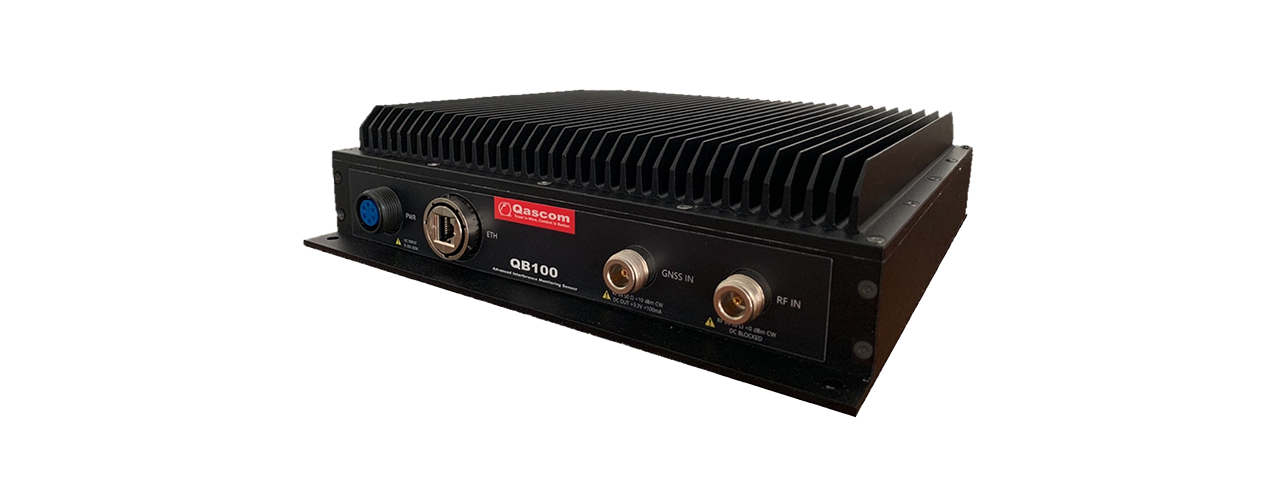Monitoring Sensors
Advanced Interference Monitoring
Sensors
Once an event is detected QB100 reports the interference to control servers that can generate alerts and notify the user. When a total of at least four sensors are used, the technology can localize the source of the interference on a map.
QB100: Advanced Interference Monitoring Sensor
The New Frontier of GNSS Signal Intelligence

QB100 is intended to be integrated in complex middle-wares and business intelligence applications, offering leading edge interference monitoring features to Value Added Resellers.
Application Areas
- Airport interference monitoring.
- Critical ground segments monitoring.
- Signal intelligence for defense.
- Timing applications monitoring.
Features
- Monitoring of multiple GNSS bands.
- State of the art detection capabilities: detection of both jamming and spoofing with complementary algorithms (8+ algorithms).
- Jamming detection sensitivity down to -125 dBm (at the QB100 Sensors antenna connector, CW signal, without external LNA), all GNSS bandwidths.
- Spoofing detection sensitivity down to J/S= -3 dB (GPS L1CA, Galileo E1BC).
- Time to detection lower than 6 s (average).
- Component deinterleaving (in frequency domain).
- Amplitude-related features estimate duty cycle, period, peak power, average power, saturation level.
- Frequency-related features estimate instantaneous bandwidth, frequency modulation period.
- Basic Classification based on binary tree (no training dataset needed).
- Advanced Classification based on artificial intelligent algorithms (training dataset needed).
- Risk ranking based on spectral mask compliancy check.
- In cluster configuration QB100 supports jamming and spoofing locations (typical configuration 4 sensors).
- Jamming and spoofing location with multiple algorithms.
- Jamming and spoofing location accuracy (CEP) down to 50 m.
- Jamming location sensitivity down to J/N= 0 dB.
- Spoofing location sensitivity down to J/S= 20 dB.
- Time to location lower than 10 s (average).
- Simplified Web-GUI for demonstrations purposes.
- HTTP +JSON communication with third party collection server.
- Ethernet connectivity, RJ45 with industrial connector.
- Monitoring antenna connector operating on GNSS bands (N-type connector).
- GNSS antenna connector (N-type connector), DC power supply (3.3V <50mA).
- Power supply 9-36 V (typical 5 A @ 12 V), custom MIL-DTL-5015 connector.
- Compact form factor.
- 24H7 field proven operational continuity.
- Flexible event logging.
- Event-triggered and periodic data recording.
- Loop-mode storage allowing post-processing analysis (HDF5 file format).
Specification
System Type
Receiver
General Info
Power Supply: 100-240 VAC 50/60 Hz
Power Consumption: Max. 30 W
Dimensions (L. x H. x D.): 280 x 280 x 70 mm
Weight: 5 kg
IP Protection Level: IP50
Working Temperature: From 0 to 40°C
Storage Temperature: From -10 to 50°C
Maximum input power (GNSS_IN)
GNSS antenna power supply (GNSS_IN): +3.3 VDC < 100 mA
Monitoring: Jamming
Operational Bandwidth: 1164-1610 MHz
Sampling frequency: 5 MSps
Sensitivity (CW Signal): -125 dBm (at RF_IN connector, without external LNA)
Detection Latency: < 6 s (typical)
Monitoring: Spoofing
GNSS Services: GPS L1 C/A, GAL E1BC
Sensitivity J/S= -3 dB
Detection Latency: < 6 s (typical)
Location
Accuracy (CEP): 50 m
Sensitivity Spoofing: J/S = 20 dB
Sensitivity Jamming: J/N = 0 dB
Location Latency: <10 s (typical)
Only in cluster mode with at least 4x QB100
And 1x QB120 software
